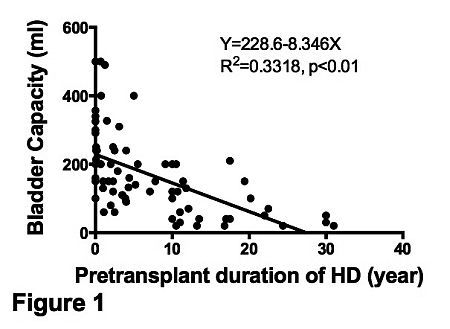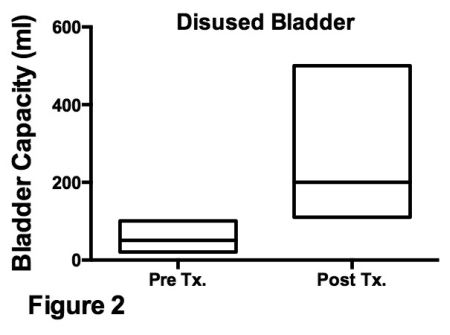Successful Kidney Transplantation Improves Bladder Capacity and Function in End-Stage Renal Disease Patients
Urology, Hokkaido University Hospital, Sapporo, Hokkaido, Japan
Meeting: 2013 American Transplant Congress
Abstract number: D1740
[Introduction] The most of patients with end-stage renal disease (ESRD) undergo hemodialysis (HD) therapy for many years in Japan. Pretransplant long-term dialysis results in disused small bladder, though it is not well known how the capacity and dysfunction are improved after transplantation. Therefore, we retrospectively evaluated the change in bladder function and capacity in kidney transplant recipients after long-term dialysis.
[Materials & Methods] Seventy-three kidney recipients (36 men, 33 women) were consecutively enrolled in this study. Mean age at transplantation was 48.6 ±11.4 years old and HD period was 7.18 ±8.13 years.
Twenty-four recipients were isolated according to pretransplant bladder capacity (BC) 100 ml or less, as disused bladder group.
First, we investigated the relationship between pretransplant dialysis and bladder capacity. Second, we evaluated the posttransplant BC and bladder function using uroflowmetry in the group.
[Results] Mean pretransplant BC was 168.7±116.9 ml, and pretransplant duration of HD showed a significant negative correlation with BC.

In disused bladder group, mean age was 51.4±8.80 years old, pretransplant duration of HD was 14.0±9.37 years, and follow-up period was 30.2±28.1 months. Pretransplant BC became significantly expanded after transplantation (Pre: 54.6±28.6ml, Post: 474.0±142.9ml, p<0.01).

Furthermore, uroflowmetry study revealed that expanded bladder after kidney transplantation had normal voiding function (Mean max free flow 20.8±9.18 ml/sec, residual urine volume 23.1±23.7 ml).
[Conclusion] Although pretransplant long-term dialysis causes bladder shrinkage, successful kidney transplantation uniformaly improves bladder capacity and function in ESRD patients.
To cite this abstract in AMA style:
Hirose T, Morita K, Hotta K, Tanabe T, Sasaki H, Mitsui T, Nonomura K. Successful Kidney Transplantation Improves Bladder Capacity and Function in End-Stage Renal Disease Patients [abstract]. Am J Transplant. 2013; 13 (suppl 5). https://atcmeetingabstracts.com/abstract/successful-kidney-transplantation-improves-bladder-capacity-and-function-in-end-stage-renal-disease-patients/. Accessed December 12, 2025.« Back to 2013 American Transplant Congress
